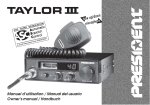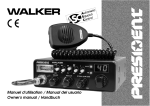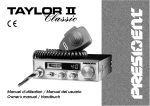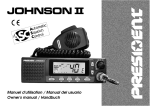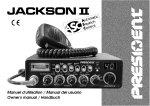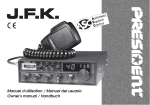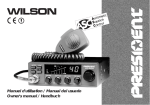Download PRESIDENT TAYLOR III Owner`s manual
Transcript
Manuel d'utilisation / Manual del usuario Owner's manual / Handbuch Votre PRESIDENT TAYLOR III ASC en un coup d'oeil Your PRESIDENT TAYLOR III ASC at a glance Un vistazo a vuestro PRESIDENT TAYLOR III ASC Ihr PRESIDENT TAYLOR III ASC auf einen Blick is SOMMAIRE França SUMARIO ol Españ INSTALLATION 5 DECLARACIÓN DE CONFORMIDAD 14 UTILISATION 7 INSTALACIÓN 16 CARACTÉRISTIQUES TECHNIQUES 8 UTILIZACIÓN 18 GUIDE DE DÉPANNAGE 9 CARACTERÍSTICAS TÉCNICAS 19 COMMENT ÉMETTRE/RECEVOIR UN MESSAGE 9 GUÍA DE PROBLEMAS 20 GLOSSAIRE 9 COMO EMITIR O RECIBIR UN MENSAJE 20 GARANTIE 12 LÉXICO 20 CERTIFICAT DE CONFORMITÉ 14 GARANTÍA 22 TABLEAU DES FRÉQUENCES 40 TABLA DE FRECUENCIAS 40 NORMES EUROPÉENNES 41 NORMAS EUROPEAS 41 SUMMARY h English INHALTSANGABE Deutsc INSTALLATION 25 INSTALLATION 32 HOW TO USE 27 BEDIENUNG 34 TECHNICAL CHARACTERISTICS 28 TECHNISCHE DATEN 35 TROUBLE SHOOTING 29 BEI PROBLEMEN 36 HOW TO TRANSMIT OR RECEIVE A MESSAGE 29 TIPS FÜR DEN FUNKVERKEHR 36 GLOSSARY 29 BEURTEILUNG DER EMPFANGSQUALITÄT 36 CERTIFICATE OF CONFORMITY 38 KONFORMITÄTSERKLÄRUNG 38 FREQUENCY TABLES 40 CB-KANÄLE UND IHRE FREQUENZEN 40 EUROPEAN NORMS 41 EUROPÄISCH NORMEN 41 3 WARNING ! Before using, be careful never to transmit without first having connected the antenna (connection "B" situated on the back panel of the equipment) or without having set the SWR (Standing Wave Ratio) ! Failure to do so may result in destruction of the power amplifier, which is not covered by the guarantee. The guarantee of this transceiver is valid only in the country of purchase . 24 Welcome to the world of the new generation of CB radios. The new PRESIDENT range gives you access to top performance CB equipment. With the use of up-todate technology, which guarantees unprecedented quality, your PRESIDENT TAYLOR III ASC is a new step in personal communication and is the surest choice for the most demanding of professional CB radio users. To ensure that you make the most of all its capacities, we advise you to read carefully this manual before installing and using your PRESIDENT TAYLOR III ASC. A) INSTALLATION: 1) WHERE AND HOW TO MOUNT YOUR MOBILE CB RADIO: a) You should choose the most appropriate setting from a simple and practical point of view. b) Your CB radio should not interfere with the driver or the passengers. c) Remember to provide for the passing and protection of different wires (e.g. power, antenna, accessory cabling) so that they do not in any way interfere with the driving of the vehicle. d) To install your equipment, use the cradle (1) and the self-tapping screws [2] provided (drilling diameter 3.2 mm). Take care not to damage the vehicle’s electrical system while drilling the dash board. e) Do not forget to insert the rubber joints [3] between the CB and its support as these have a shock-absorbing effect which permits gentle orientation and tightening of the set. f) Choose where to place the microphone support and remember that the microphone cord must stretch to the driver without interfering with the controls of the vehicle. - N.B. : As the transceiver has a frontal microphone socket, it can be set into the dash board. In this case, you will need to add an external loud speaker to improve the sound quality of communications (connector EXT.SP situated on the back panel: C). Ask your dealer for advice on mounting your CB radio. MOUNTING DIAGRAM 25 2) ANTENNA INSTALLATION: 3) POWER CONNECTION: Your PRESIDENT TAYLOR III ASC is protected against an inversion of polarities. However, before switching it on, you are advised to check all the connections. Your equipment must be supplied with a continued current of 12 volts (A). Today, most cars and lorries are negative earth. You can check this by making sure that the negative terminal of the battery is connected either to the engine block or to the chassis. If this is not the case, you should consult your dealer. a) Choosing your antenna: - For CB radios, the longer the antenna, the better its results. Your dealer will be able to help you with your choice of antenna. b) Mobile antenna: - Must be fixed to the vehicle where there is a maximum of metallic surface (ground plane), away from windscreen mountings. - If you already have a radio-telephone antenna installed, the CB antenna should be higher than this. - There are two types of antenna: pre-regulated which should be used on a good ground plane (e.g. car roof or lid of the boot), and . adjustable which offer a much larger range and can be used on a smaller ground plane (see p 27 § 5, Adjustment of SWR). - For an antenna which must be fixed by drilling, you will need a good contact between the antenna and the ground plane. To obtain this, you should lightly scratch the surface where the screw and tightening star are to be placed. - Be careful not to pinch or flatten the coaxial cable (as this runs the risk of break down and/or short circuiting). - Connect the antenna (B). WARNING: Lorries generally have two batteries and an electrical installation of 24 volts, in which case it will be necessary to insert a 24/12 volt converter (type CV 24/12 PRESIDENT) into the electrical circuit. The following connection steps should be carried out with the power cable disconnected from the set. a) Check that the battery is of 12 volts. b) Locate the positive and negative terminals of the battery (+ is red and - is black). Should it be necessary to lengthen the power cable, you should use the same or a superior type of cable. c) It is necessary to connect your CB to a permanent (+) and (-). We advise you to connect the power cable directly to the battery (as the connection of the CB cable to the wiring of the car-radio or other parts of the electrical circuit may, in somecases, increase the likelihood of interference). d) Connect the red wire (+) to the positive terminal of the battery and the black (-) wire to the negative terminal of the battery. e) Connect the power cable to your CB radio. c) Fixed antenna: - A fixed antenna should be installed in a clear a space as possible. If it is fixed to a mast, it will perhaps be necessary to stay it, according to the laws in force (you should seek professional advice). All PRESIDENT antennas and accessories are designed to give maximum efficiency to each CB radio within the range. WARNING: Never replace the original fuse (2 A) by one of a different value. Zum starter Towards starter Zum chassis Connected to chassis OUTPUT RADIUS PATTERNS 26 4) BASIC OPERATIONS TO BE CARRIED OUT BEFORE USING YOUR SET FOR THE FIRST TIME (without transmitting and without using the «push-to-talk» switch on the microphone): B) HOW TO USE YOUR CB: a) Connect the microphone b) Check the antenna connections c) Turn the set on by turning the knob VOLUME clockwise. d) Turn the SQUELCH knob to minimum (anti-clockwise). Adjust the volume to a comfortable level. e) Go to Channel 20 using the rotary knob on the front panel. a) To turn the set on, turn the knob (1) clockwise b) To increase the sound level, turn the same knob further clockwise. 1) ON/OFF - VOLUME: 2) ASC (Automatic Squelch Control)/SQUELCH: Suppresses undesirable back-ground noises when there are no communication. Squelch does not effect neither sound nor transmission power, but allows a considerable improvement in listening comfort. 5) ADJUSTMENT OF SWR (Standing wave ratio): WARNING: This must be carried out when you use your CB radio for the first time (and whenever you re-position your antenna). The adjustment must be carried out in an obstacle-free area. a) ASC: Automatic Squelch Control Worldwide patent, a PRESIDENT exclusivity No repetitive manual adjustment and a permanent improvement in listening comfort when this function is active. It can be disconnected by turning the switch (2) clockwise, in this case the manual squelch control becomes active again. * Using an external SWR meter (e.g. SWR 1 or SWR 2): a) To connect the SWR meter : - Connect the SWR meter between the CB radio and the antenna as close as possible to the CB (use a maximum of 40 cm cable, type President CA 2C). b) Turn the squelch knob clockwise to the exact point where all back-ground noise disappears. This adjustment should be done with precision as, if set to maximum, (i.e. fully clockwise) only the strongest signals will be received. b) To adjust the SWR meter: - Set the CB to channel 20. - Put the switch on the SWR meter to position CAL ou FWD. - Press the «push-to-talk» switch on the microphone to transmit. - Bring the index needle to ▼ by using the calibration key. - Change the switch to position SWR (reading of the SWR level). The reading on the V.U. meter should be as near as possible to 1. If this is not the case, re-adjust your antenna to obtain a reading as close as possible to 1. (An SWR reading between 1 and 1.8 is acceptable). - It will be necessary to re-calibrate the SWR meter after each adjustment of the antenna. 3) CHANNEL SELECTOR ROTARY KNOB: Turning this knob allows you to choose a channel (1-40) for transmitting and receiving. A beep is heard every time the channel is changed. 4) DISPLAY: The display shows all the different functions. The S-METER shows the level of reception and the level of power emitted. Your CB is now ready for use. 27 5) MODE: C) TECHNICAL CHARACTERISTICS: Use this key to select AM or FM. The modulation mode must correspond with that of the person with whom you communicate. A/ Amplitude Modulation (AM) is for communications in areas where there are obstacles and over medium distances. B/ Frequency Modulation (FM) is for nearby communications in flat, open areas. It gives better quality of communication (squelch adjustment needs more finesse). 1) GENERAL: - 6) 6-PIN MICROPHONE PLUG: This plug is situated on the front panel, thereby making it easier to set the equipment into the dashboard. See the cabling diagram on page 43. 7) UP AND DOWN KEYS: Channels Modulation modes Frequency ranges Antenna impedance Power supply Dimensions (in mm) Weight Accessories supplied : : : : : : : : 40 AM/FM from 26.965 MHz to 27.405 MHz 50 ohms 13.2 V 150 (L) x 165 (H) x 45 (D) 1.2 kg Microphone with support, mounting cradle, screws : : : : : : : : +/- 300 Hz 1 W AM / 4 W FM inferior to 4 nW (- 54 dBm) 300 Hz à 3 kHz in AM/FM inferior to 20 µW 1,0 mV 1,7 A (with modulation) 1,8 % 2) TRANSMISSION: Both keys allow to go up and down the channels by a brief pression. A continuous pression allows to ascend five channels per second. - 8) PTT (push to talk): Depress this knob to transmit a message and release to listen to an incoming communication. A) DC-POWER TERMINAL (13,2 V) Frequency allowance Carrier power Transmission interference Audio response Emitted power in the adj. channel Microphone sensitivity Drain Modulated signal distortion 3) RECEPTION: B) ANTENNA CONNECTOR (SO-239) - C) EXTERNAL SPEAKER JACK (8 W, Ø 3,5 mm) Maxi. sensitivity at 20 dB sinad Frequency response Adjacent channel selectivity Maximum audio power Squelch sensitivity - Frequency image rejection rate - Intermediate frequency rej. rate - Drain 28 : : : : : 0.5 µV - 113 dBm (AM/FM) 300 Hz à 3 kHz in AM/FM 60 dB 5W minimum 0.2 µV - 120 dBm maximum 1 mV - 47 dBm : 60 dB : 70 dB : 500 mA nominal 800 mA maximum D) TROUBLE SHOOTING F) GLOSSARY: Below you will find some of the most frequently used CB radio expressions. Remember this is meant for fun and that you are by no means obliged to use them. In an emergency, you should be as clear as possible. 1) YOUR CB RADIO WILL NOT TRANSMIT OR YOUR TRANSMISSION IS OF POOR QUALITY: - Check that the antenna is correctly connected and that the SWR is properly adjusted. - Check that the microphone is properly plugged in. INTERNATIONAL PHONETIC ALPHABET: A B C D E F G 2) YOUR CB RADIO WILL NOT RECEIVE OR RECEPTION IS POOR: - Check that the squelch level is properly adjusted. Check that the volume is set to a comfortable listening level. Check that the microphone is properly plugged in. Check that the antenna is correctly connected and that the SWR is properly adjusted. - Check that you are using the same modulation mode as your correspondent. Alpha Bravo Charlie Delta Echo Foxtrott Golf H I J L M N O Hotel India Juliett Lima Mike November Oscar P Q R S T U V Papa Quebec Romeo Sierra Tango Uniform Victor TECHNICAL VOCABULARY: DW FM GMT HF LF LSB RX SSB SWR SWL SW TX UHF USB VHF 3) YOUR CB WILL NOT LIGHT UP: - Check the power supply. - Check the connection wiring. - Check the fuse. E) HOW TO TRANSMIT OR RECEIVE A MESSAGE: Now that you have read the manual, make sure that your CB Radio is ready for use (i.e. check that your antenna is connected). Choose your channel (19, 27). Choose your mode (AM/FM) which must be the same as that of your correspondent. Press the «push-to-talk» switch and announce your message «Attention stations, transmission testing» which will allow you to check the clearness and the power of your signal. Release the switch and wait for a reply. You should receive a reply like, «Strong and clear». If you use a calling channel (19, 27) and you have established communication with someone, it is common practice to choose another available channel so as not to block the calling channel. : : : : : : : : : : : : : : : Dual Watch Frequency Modulation Greenwich Meantime High Frequency Low Frequency Lower Side Band Receiver Single Side Band Standing Wave Ratio Short Wave Listening Short Wave CB Transceiver Ultra High Frequency Upper Side Band Very High Frequency : : : : : : : Flashing lights of police car Slow down Channel 1 A CB set in fixed location Policeman Speeding fine Police station CB LANGUAGE: Advertising Back off Basement Base station Bear Bear bite Bear cage 29 W Y Z Whiskey Yankee Zulu Big slab Big 10-4 Bleeding : : : Blocking the channel : Blue boys : Break : Breaker : Clean and green : Cleaner channel : Coming in loud and proud : Doughnut : Down and gone : Down one : Do you copy? : DX : Eighty eights : Eye ball : Good buddy : Hammer : Handle : Harvey wall banger : How am I hitting you? : Keying the mike : Kojac with a kodak : Land line : Lunch box : Man with a gun : Mayday : Meat wagon : Midnight shopper : Modulation : Negative copy : Over your shoulder : Part your hair : Pull your hammer back : Rat race : Rubberbander : Sail boat fuel : Smokey dozing : Smokey with a camera : Spaghetti bowl : Stinger : Turkey : Up one : Wall to wall : What am I putting to you? : Motorway Absolutely Signal from an adjacent channel interfering with the transmission Pressing the PTT switch without talking Police Used to ask permission to join a conversation A CBer wishing to join a channel Clear of police Channel with less interference Good reception Tyre Turning CB off Go to a lower channel Understand? Long distance Love and kisses CBers meeting together Fellow CBer Accelerator CBer’s nickname Dangerous driver How are you receiving me? Pressing the PTT switch without talking Police radar Telephone CB set Police radar SOS Ambulance Thief Conversation No reply Right behind you Behave yourself - police ahead Slow down Congested traffic New CBer Wind Parked police car Police radar Interchange Antenna Dumb CBer Go up one channel All over/everywhere Please give me an S-meter reading. 30 CERTIFICATE OF CONFORMITY KONFORMITÄTSERKLÄRUNG We, GROUPE PRESIDENT ELECTRONICS, Route de Sète, BP 100 – 34540 Balaruc – FRANCE, Wir, GROUPE PRESIDENT ELECTRONICS, Route de Sète, BP 100 – 34540 Balaruc – FRANCE, Declare, on our own responsibility that the CB radio-communication transceiver Erklären, auf eigene Verantwortung daß der CB Funk SenderEmpfänger Brand : PRESIDENT Model : TAYLOR III Manufactured in PRC Marke : PRESIDENT Modell : TAYLOR III Hergestellt in PRC is in conformity with the essential requirements of the Directive 1999/5/CE (Article 3) adapted to the national law, as well as with the following European Standards: in Konformität ist mit den wesentlichen Anforderungen der R & TTE Richtlinie 1999/5/CE (Artikel 3) auf die nationale Gesetzen umgestellt, wie mit den folgenden europäischen Normen: EN 300 135-2:v1.1.1 (2000) EN 300 433-2 :v1.1.2 (2000) EN 301 489-13 v 1.2.1 (2002) EN 60215 ( 1996) EN 300 135-2:v1.1.1 (2000) EN 300 433-2 :v1.1.2 (2000) EN 301 489-13 v 1.2.1 (2002) EN 60215 ( 1996) Balaruc, the 2004-06-14 Balaruc, den 14/06/2004 Jean-Gilbert MULLER General Manager Jean-Gilbert MULLER Geschäftsführer 38 39 PRISE MICRO 6 BROCHES CONEXIÓN DEL MICRO 6 PINS 6-PIN MICROPHONE PLUG BELEGUNG DER MIKRO-FONBUCHSE (sechspolig) TABLEAU DES FRÉQUENCES TABLA DE FRECUENCIAS FREQUENCY TABLES CB-KANÄLE UND IHRE FREQUENZEN N° du canal Nº Canal Channel Kanal Fréquences Frecuencia Frequency Frequenzens N° du canal Nº Canal Channel Kanal Fréquences Frecuencia Frequency Frequenzens 1 26,965 MHz 21 27,215 MHz 2 26,975 MHz 22 27,225 MHz 3 26,985 MHz 23 27,255 MHz 4 27,005 MHz 24 27,235 MHz 5 27,015 MHz 25 27,245 MHz 6 27,025 MHz 26 27,265 MHz 7 27,035 MHz 27 27,275 MHz 8 27,055 MHz 28 27,285 MHz 9 27,065 MHz 29 27,295 MHz 10 27,075 MHz 30 27,305 MHz 11 27,085 MHz 31 27,315 MHz 12 27,105 MHz 32 27,325 MHz 13 27,115 MHz 33 27,335 MHz 14 27,125 MHz 34 27,345 MHz 15 27,135 MHz 35 27,355 MHz 16 27,155 MHz 36 27,365 MHz 17 27,165 MHz 37 27,375 MHz 18 27,175 MHz 38 27,385 MHz 19 27,185 MHz 39 27,395 MHz 20 27,205 MHz 40 27,405 MHz 1 2 3 4 5 6 40 Modulation RX TX UP/DOWN Masse Alimentation Modulación RX TX UP/DOWN Masa Alimentación Modulation RX TX UP/DOWN Ground Power Supply Modulation RX TX UP/DOWN Masse Stromversorgung NORMES EUROPÉENNES - NORMAS EUROPEAS - EUROPEAN NORMS - EUROPÄISCH NORMEN La bande de fréquence et la puissance d’émission de votre appareil doit correspondre à la configuration autorisée dans le pays où il est utilisé. La banda de frecuencias y la potencia de emisión de su aparato deben corresponder a la configuración autorizada en el país donde él es utilizado. The frequency band and the transmission power of your transceiver must correspond with the configuration authorized in the country where it is used. Das Frequenzband und die Sendungsleistung Ihres Gerätes müssen übereinstimmen mit den Normen zugelassen im Land worin es benutzt ist. 41 UTZZ01369ZZ 0341 0605/08-04 SIEGE SOCIAL/HEAD OFFICE - FRANCE Route de Sète - BP 100 - 34540 BALARUC Site Internet : http://www.president-electronics.com E-mail : [email protected]















